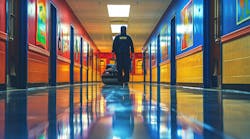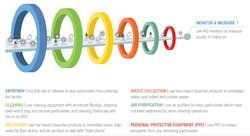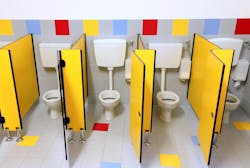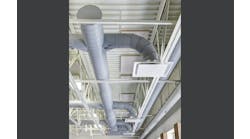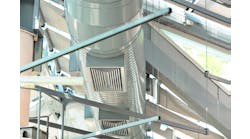Over the last 100 years, society has seen significant gains in public health with regard to water quality, outdoor air pollution, food safety, and general health, hygiene, and sanitation. Several improvements have been crucial in evolving the building occupant wellness expectations of students, faculty, and visitors at a school or university campus.
Where does Indoor Air Quality (IAQ) fit in public health advancements, and what’s needed for a total facility care approach for campuses going forward?
The Covid-19 pandemic and recent wildfires in some areas have demonstrated the dramatic need for improvements in IAQ on higher education campuses. How institutions clean and maintain the built environment on campuses plays a vital role in achieving more healthful IAQ.
Enhanced IAQ cleaning protocols help reduce the spread of infectious respiratory diseases, protect against airborne allergens, and diminish the effects of wildfire smoke and other indoor air pollutants.
IAQ Impact
Americans, on average, spend up to 90% of their time indoors.
Considering that indoor air is typically two to five times more polluted than outdoor air, is it any wonder that one in five Americans suffers from allergies and asthma?
Joseph Allen, director of the Healthy Buildings Program at Harvard T.H. Chan School of Public Health, makes the case that facility managers now play a more significant role in the health of building occupants than their personal care physicians do.
Thinking differently about cleaning protocols can help eliminate, substitute, or apply engineering or administrative controls to address hazards posed by airborne particulates before they ever reach the HVAC system – or building occupants’ lungs.
Regular deployment of portable air purifiers supplemented with periodic use of personal protective equipment (PPE) for increased exposure risks can help mitigate against airborne transmission of infectious aerosols and help protect the health of building occupants.
So, what does cleaning differently look like?
It looks a lot like green cleaning with a few important evolutions and modifications.
Entryway IAQ
First, deploy entryway matting systems to help trap and remove dirt, moisture, and other particulates so they don’t enter a building in the first place. Did you know that 70% to 80% of the dirt in buildings is tracked in on the bottom of shoes? These particulates then circulate within a building until removal.
Entryway matting systems can help eliminate airborne particulates so they don't have to be dealt with later.
Cleaning IAQ
Next, clean hard floors and other horizontal and vertical surfaces with microfiber instead of traditional cleaning tools like cotton mops and feather dusters. Microfiber is more effective at trapping and removing dirt, moisture, and other particulates from all surfaces than other cleaning tools that frequently just move dirt and particulates around to settle somewhere else in a building.
Also, use vacuum cleaners with filtration. Vacuum cleaners certified by the Carpet & Rug Institute Seal of Approval Green Label have been proven to trap, remove, and, most important, keep particulates contained so they are not redistributed to settle on surfaces and be breathed in by students and other building occupants. High-Efficiency Particulate Air (HEPA) filters are available for many vacuum cleaners and can provide even better filtration.
For other cleaning equipment, consider solutions that collect and remove particulates instead of just moving them around. Think autoscrubbers instead of mops for cleaning floors, no-touch cleaning caddies instead of cleaning cloths for cleaning restrooms, and floor burnishers with dust skirts and active vacuum dust capture instead of those without. In addition to helping with IAQ, mechanizing the cleaning process helps the cleaning staff be more effective and efficient.
For cleaning chemicals, consider those that are third-party certified to meet standards from Green Seal, UL ECOLOGO, or EPA Safer Choice. These certified products have been demonstrated to have a reduced effect on human health and the environment, and recent studies have concluded that these products also typically emit fewer Volatile Organic Compounds (VOCs) than traditional products used for the same purposes. VOCs can cause respiratory irritation for cleaning staff as well as students and faculty.
Consider also cleaning chemicals with supplemental certifications that address VOCs specifically, including UL GREENGUARD and Clean Air Choice Cleaners Certification from South Coast Air Quality Management District – each of these standards conducts air chamber testing with these cleaning chemicals to identify those which have low or no VOCs.
Restroom IAQ
For restroom air, floor drain trap seals help protect building occupants from pests and odors that can be spread throughout a building via pipes and plumbing. Using bioactive drain maintainers also helps mitigate the odors caused by fats, oils, and greases in the pipes, and helps keep the drains flowing when incorporated into a regular drain care protocol.
Bioactive chemistry is typically a low-VOC way to clean restrooms; several formulas have received third-party green certification and are effective at remediating organic matter typically found in restrooms that cause malodors and provide a haven for pathogens to grow.
To combat the negative effects of "toilet plume" on the quality of restroom air, disinfectant bowl cleaners and air purifiers can help mitigate potential exposure of students and staff to the pathogens aerosolized and spread throughout the restroom with each flush.
Waste IAQ
When designing waste management protocols, be mindful of pathogens that may be present in waste, recyclable, and compostable materials, and mitigate against potential exposure. Collecting, moving, and storing these waste materials should be focused on containing them to avoid producing malodors or any other airborne particulates of concern. Again, bioactive chemistry can be used to keep receptacles and carts clean from organic material and residue buildup.
Air Purifier IAQ
The next step is to begin cleaning the air. Bringing portable air purifiers into building spaces can help clean up airborne particulates not addressed by the enhanced IAQ cleaning protocols described previously. The U.S. Environmental Protection Agency, the Centers for Disease Control and Prevention, and the American Society of Heating, Refrigerating, and Air Conditioning Engineers all recommend air purifiers using HEPA filters. These air purifiers have been proven to mitigate against Covid-19, cold and influenza, and seasonal allergies. They also are effective at clearing out smoke from wildfires, cigarettes, cigars, and marijuana.
PPE IAQ
For any particulates not addressed by cleaning differently with enhanced IAQ protocols, or by using air purifiers, PPE can be deployed to protect students and staff from harmful particulates during times of increased risk.
PPE is the last step in mitigating hazards not addressed by protocols designed to eliminate, substitute, or engineer out a hazard.
In understanding the important roles enhanced hand hygiene, surface cleaning and high touchpoint disinfecting play in protecting public health, one can see the critical role that cleaning also plays in mitigating exposure to airborne allergens, malodors, and infectious pathogens at schools and universities.
Keith Schneringer is Senior Director of Marketing, Facility Care + Sustainability, at BradyPLUS.
Sidebar:
Federal program offers $180 million for school energy upgrades
The U.S. Department of Energy has opened applications for the 2024 Renew America's Schools Prize, which will award $180 million to districts engaging in strategic partnerships to build capacity and carry out energy upgrades at K-12 schools.
The aim of the awards is to lower energy use and costs, improve indoor air quality, and foster more healthful learning environments.
“There’s nothing more critical than investing in the health and education of our nation’s children,” said U.S. Secretary of Energy Jennifer M. Granholm. "This program's first round of funding saw an unprecedented influx of applications, requesting billions in school infrastructure upgrades."
The 2024 Renew America’s Schools Prize will invest an anticipated $180 million in school facilities that demonstrate the need for energy improvements and financing. The program will focus on schools that serve disadvantaged communities, including those with a high percentage of students eligible for free and reduced-price lunch, or which qualify as rural.
The energy department says in a news release that eligible improvements – such as new HVAC and ventilation systems, building envelope and lighting projects, alternative fuel (such as electric) vehicles and infrastructure, and renewable energy technologies – will improve energy performance or lead to improvements in student, educator, and staff health.
By reducing energy use, these improvements can reduce building operating costs – the second highest operational expense for schools.
Learning environments that have been enhanced with better indoor air quality, lighting, and other upgrades can boost student health outcomes and improve overall well-being and academic performance, the energy department says.
Competitive proposals will consist of energy assessments and building improvement projects across a portfolio of 10 or more school facilities. A portfolio may be composed of school facilities from one or more districts.
In 2023, this program's first round of funding awarded $178 million in Renew America’s Schools grants, which benefited over 90 school facilities across 22 states.
Applications for the 2024 Renew America’s Schools Prize are due on June 13.
To access the 2024 Renew America’s Schools Prize, visit https://www.herox.com/renewschoolsprize. To view the tools and resources that will support an application, visit /scep/renew-americas-schools.
